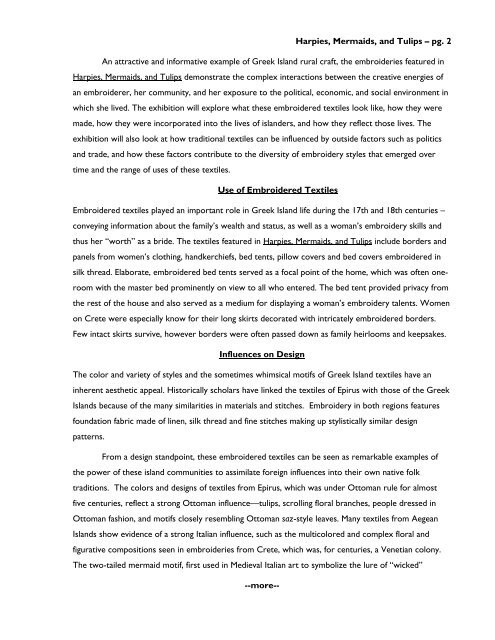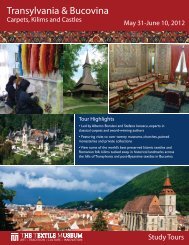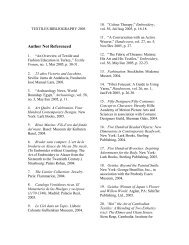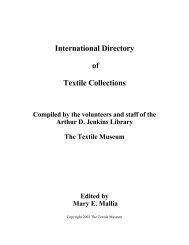Harpies, Mermaids, and Tulips: Embroidery of the ... - Textile Museum
Harpies, Mermaids, and Tulips: Embroidery of the ... - Textile Museum
Harpies, Mermaids, and Tulips: Embroidery of the ... - Textile Museum
Create successful ePaper yourself
Turn your PDF publications into a flip-book with our unique Google optimized e-Paper software.
<strong>Harpies</strong>, <strong>Mermaids</strong>, <strong>and</strong> <strong>Tulips</strong> – pg. 2<br />
An attractive <strong>and</strong> informative example <strong>of</strong> Greek Isl<strong>and</strong> rural craft, <strong>the</strong> embroideries featured in<br />
<strong>Harpies</strong>, <strong>Mermaids</strong>, <strong>and</strong> <strong>Tulips</strong> demonstrate <strong>the</strong> complex interactions between <strong>the</strong> creative energies <strong>of</strong><br />
an embroiderer, her community, <strong>and</strong> her exposure to <strong>the</strong> political, economic, <strong>and</strong> social environment in<br />
which she lived. The exhibition will explore what <strong>the</strong>se embroidered textiles look like, how <strong>the</strong>y were<br />
made, how <strong>the</strong>y were incorporated into <strong>the</strong> lives <strong>of</strong> isl<strong>and</strong>ers, <strong>and</strong> how <strong>the</strong>y reflect those lives. The<br />
exhibition will also look at how traditional textiles can be influenced by outside factors such as politics<br />
<strong>and</strong> trade, <strong>and</strong> how <strong>the</strong>se factors contribute to <strong>the</strong> diversity <strong>of</strong> embroidery styles that emerged over<br />
time <strong>and</strong> <strong>the</strong> range <strong>of</strong> uses <strong>of</strong> <strong>the</strong>se textiles.<br />
Use <strong>of</strong> Embroidered <strong>Textile</strong>s<br />
Embroidered textiles played an important role in Greek Isl<strong>and</strong> life during <strong>the</strong> 17th <strong>and</strong> 18th centuries –<br />
conveying information about <strong>the</strong> family’s wealth <strong>and</strong> status, as well as a woman’s embroidery skills <strong>and</strong><br />
thus her “worth” as a bride. The textiles featured in <strong>Harpies</strong>, <strong>Mermaids</strong>, <strong>and</strong> <strong>Tulips</strong> include borders <strong>and</strong><br />
panels from women’s clothing, h<strong>and</strong>kerchiefs, bed tents, pillow covers <strong>and</strong> bed covers embroidered in<br />
silk thread. Elaborate, embroidered bed tents served as a focal point <strong>of</strong> <strong>the</strong> home, which was <strong>of</strong>ten oneroom<br />
with <strong>the</strong> master bed prominently on view to all who entered. The bed tent provided privacy from<br />
<strong>the</strong> rest <strong>of</strong> <strong>the</strong> house <strong>and</strong> also served as a medium for displaying a woman’s embroidery talents. Women<br />
on Crete were especially know for <strong>the</strong>ir long skirts decorated with intricately embroidered borders.<br />
Few intact skirts survive, however borders were <strong>of</strong>ten passed down as family heirlooms <strong>and</strong> keepsakes.<br />
Influences on Design<br />
The color <strong>and</strong> variety <strong>of</strong> styles <strong>and</strong> <strong>the</strong> sometimes whimsical motifs <strong>of</strong> Greek Isl<strong>and</strong> textiles have an<br />
inherent aes<strong>the</strong>tic appeal. Historically scholars have linked <strong>the</strong> textiles <strong>of</strong> Epirus with those <strong>of</strong> <strong>the</strong> Greek<br />
Isl<strong>and</strong>s because <strong>of</strong> <strong>the</strong> many similarities in materials <strong>and</strong> stitches. <strong>Embroidery</strong> in both regions features<br />
foundation fabric made <strong>of</strong> linen, silk thread <strong>and</strong> fine stitches making up stylistically similar design<br />
patterns.<br />
From a design st<strong>and</strong>point, <strong>the</strong>se embroidered textiles can be seen as remarkable examples <strong>of</strong><br />
<strong>the</strong> power <strong>of</strong> <strong>the</strong>se isl<strong>and</strong> communities to assimilate foreign influences into <strong>the</strong>ir own native folk<br />
traditions. The colors <strong>and</strong> designs <strong>of</strong> textiles from Epirus, which was under Ottoman rule for almost<br />
five centuries, reflect a strong Ottoman influence—tulips, scrolling floral branches, people dressed in<br />
Ottoman fashion, <strong>and</strong> motifs closely resembling Ottoman saz-style leaves. Many textiles from Aegean<br />
Isl<strong>and</strong>s show evidence <strong>of</strong> a strong Italian influence, such as <strong>the</strong> multicolored <strong>and</strong> complex floral <strong>and</strong><br />
figurative compositions seen in embroideries from Crete, which was, for centuries, a Venetian colony.<br />
The two-tailed mermaid motif, first used in Medieval Italian art to symbolize <strong>the</strong> lure <strong>of</strong> “wicked”<br />
--more--





